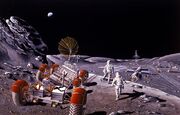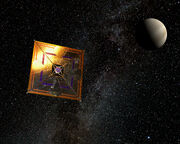Introduction[]

Science and technology has been advancing for many thousands of years and advances at different paces at different times. Their are times throughout history when the knowledge of the earlier period would seem more advanced then what the people of the "today" could do. Perhaps the greatest example of that would be post-Roman Europe as the locals would live in the shadows the greatness of the dead Empire with aqueducts, roads and great buildings or monuments marking the extent of the old empire. Yet much of the knowledge of the ancients was alive and being studied by Muslims, in their empire who had acquired parts of the old empire and was able to learn from then advance the worlds knowledge.
In OTL a similar circumstance would appear to be taking place as our ability to enter space and travel to the moon has been lost, while others continue to learn from what we once had. Of course this could change on the whim of either a politicians "push" back into space or a businessman willingness to spend his/her fortune on such a risky venture.

The science and technology of the Space Race Didn't End timeline is more advanced than in OTL. However the advancement of this technology has built up slowly over tha last several decades and did not require any major leaps in technology. All the technologies existed at the POD and unlike OTL did not see decades of budget cuts and uncertainty of the future of programs. Instead the space program and other sciences received a steady and ever increasing flow of capital and support for most politicians and business. Today the world enjoys a cleaner environment and has the opportunity to travel to low earth orbit (LEO) or to the moon. Travel to the inner planets is possible on ship similar to cruise ship of OTL but is restricted to the wealthy and leaving the ships to visit these worlds is not possible as their are no resources to support tourist.
Other areas that have advance during the last several decades include computer technologies, life sciences and medicines, nuclear energies and other clean technologies and robotics.
Space Travel[]
Early history[]

Robert Goddard and the first liquid-fueled rocket
Mercury[]

Left to right: Grissom, Shepard, Carpenter, Schirra, Slayton, Glenn and Cooper, 1962
Gemini[]

Rendezvous of Gemini 6 and 7, December 1965
Apollo[]

Apollo returning home
While the Saturn V is the largest and most powerful ship ever built up until 1971 this is when NASA started using the Saturn V (D). The decision to use the Saturn V (D) was made because all it needed was to adapt the Saturn V so that boosters could be attached and to stretch the core fuel tanks for a longer burn time and by doing so nearly triple the payload to LEO. This allowed construction of NASA's first space station with only 8 flights. While the cost came down because instead of the allowing the first stage to fall into the Pacific and sink to the bottom the ocean NASA had redesigned the Block Two Saturn V in 1970 with parachutes and made it air tight so they could be recovered, this allowed them to be refurbished and reused. As the cost came down the excitement and public support increased as the Nixon administration pushed for the nation's support after the Soviets landed on the moon and announced plans to go to Venus.
Current Efforts[]

Nuclear Pulse Rocket
Research Labs on and off earth[]

Skylab C
Orbital Ships[]

Luna Colonies[]

Interplanetary Ships[]
Mars Bases[]
Inner System[]

Solar sail, with cargo, on the way to Venus
Outer System[]
Deep Space[]
Ongoing[]
Life Sciences[]
Computer Tech[]
History

Cray I super computer early 1970's
Moorse Law
Military Technology[]
Energy Technologies[]
Robotics[]

Robotics: a new and powerful tool
